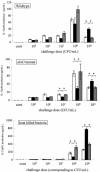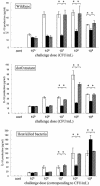Differential roles of Toll-like receptors 2 and 4 in in vitro responses of macrophages to Legionella pneumophila
- PMID: 15618172
- PMCID: PMC538926
- DOI: 10.1128/IAI.73.1.352-361.2005
Differential roles of Toll-like receptors 2 and 4 in in vitro responses of macrophages to Legionella pneumophila
Abstract
The role of Toll-like receptors (TLRs) in innate immunity to Legionella pneumophila, a gram-negative facultative intracellular bacterium, was studied by using bone marrow-derived macrophages and dendritic cells from TLR2-deficient (TLR2(-/-)), TLR4(-/-), and wild-type (WT) littermate (C57BL/6 x 129Sv) mice. Intracellular growth of L. pneumophila was enhanced within TLR2(-/-) macrophages compared to WT and TLR4(-/-) macrophages. There was no difference in the bacterial growth within dendritic cells from WT and TLR-deficient mice. Production of interleukin-12p40 (IL-12p40) and IL-10 after infection with L. pneumophila was attenuated in TLR2(-/-) macrophages compared to WT and TLR4(-/-) macrophages. Induction of IL-12p40, IL-10, and tumor necrosis factor alpha secretion from macrophages by the L. pneumophila dotO mutant, which cannot multiply within macrophages, and heat-killed bacteria, was similar to that caused by a viable virulent strain. There was no difference between the WT and its mutants in susceptibility to the cytopathic effect of bacteria. An L. pneumophila sonicated lysate induced IL-12p40 production by macrophages, but that of TLR2(-/-) macrophages was significantly lower than those of WT and TLR4(-/-) macrophages. Treatment of L. pneumophila sonicated lysate with proteinase K and heating did not abolish TLR2-dependent IL-12p40 production. Our results show that TLR2, but not TLR4, is involved in murine innate immunity against L. pneumophila, although other TLRs may also contribute to innate immunity against this organism.
Figures








References
-
- Abel, B., N. Thieblemont, V. J. Quesniaux, N. Brown, J. Mpagi, K. Miyake, F. Bihl, and B. Ryffel. 2002. Toll-like receptor 4 expression is required to control chronic Mycobacterium tuberculosis infection in mice. J. Immunol. 169:3155-3162. - PubMed
-
- Alexopoulou, L., A. C. Holt, R. Medzhitov, and R. A. Flavell. 2001. Recognition of double-stranded RNA and activation of NF-κB by Toll-like receptor 3. Nature 413:732-738. - PubMed
-
- Beckers, M. C., E. Ernst, E. Diez, C. Morissette, F. Gervais, K. Hunter, D. Hous-man, S. Yoshida, E. Skamene, and P. Gros. 1997. High-resolution linkage map of mouse chromosome 13 in the vicinity of the host resistance locus. Lgn1. Genomics 39:254-263. - PubMed
-
- Berger, K. H., and R. R. Isberg. 1993. Two distinct defects in intracellular growth complemented by a single genetic locus in Legionella pneumophila. Mol. Microbiol. 7:7-19. - PubMed
Publication types
MeSH terms
Substances
LinkOut - more resources
Full Text Sources
Molecular Biology Databases

